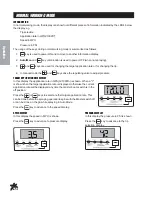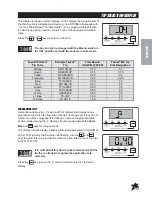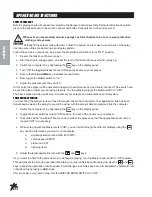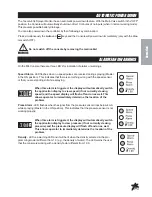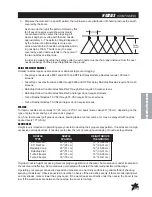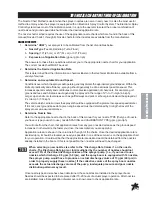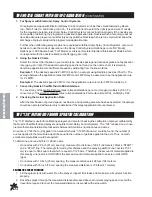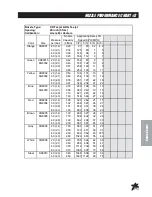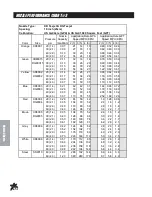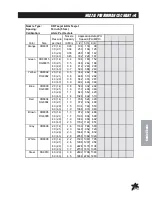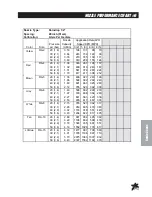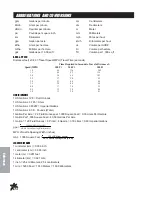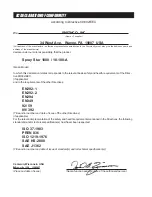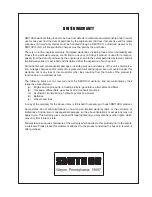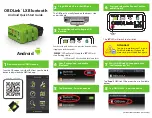
31
Spraying Procedures
THE “128” METHOD OF BOOM SPRAYER CALIBRATION
(CONTINUED)
The carrying or towing vehicle is to be traveling at the desired speed when it crosses the start line of the
measured course.
Repeat this procedure and determine the average of the two times.
3. With the sprayer parked, run the sprayer at the required pressure level. Catch the output of each nozzle in
a container which is marked or graduated in Ounces for the exact same period of time which it took the
sprayer to cover the measured course in step #2. It is necessary to operate the vehicle engine at spraying
speed using a hand throttle.
4. Observe the volume of water in the collection bottle. The number of OUNCES collected in the time it takes
to cover the marked course. Take the average nozzle output by adding the outputs of each nozzle and
then dividing that sum by the number of nozzles.
The NUMBER OF OUNCES collected in the time required to cover the SMALL AREA is equal to the
NUMBER OF GALLONS applied per ACRE. For example: if an average of 40 ounces of water is collected
in the time required to cover the 1/128 acre area, the application rate is 40 gallons per acre (gpa).
As a practical matter, if high application rates are desired (above 75 gpa), the measured
course length should be reduced by half (i.e. 102 ft (31 m) for 20 inch (52 cm) spaced
nozzles). The volume collected (above) is then doubled (multiplied by 2).
AVERAGE OUTPUT (Ounces) = APPLICATION RATE (gpa)
5. Observe individual nozzle output volumes. If an individual nozzle is 10% above or below the average
output, check for blockages in the nozzle or in the nozzle strainer. If the nozzle is worn or damaged,
replace it.
6. Compare this actual application rate with the recommended rate. If the actual rate is more than 5% higher
or lower than the intended rate, adjustments must be made.
7. Minor adjustments in application rate may be made by increasing or decreasing the spraying pressure.
Lowering spraying pressure decreases application rate. Increasing spraying pressure increases applica-
tion rate. This procedure normally does not apply to spray systems controlled by an Electronic Spray
Control System, which governs flow rate.
8. Adjustments in application rate may be made by increasing or decreasing the travel speed of the sprayer
if conditions permit. Slower speeds increase application rate. Faster speeds decrease application rate.
9. Nozzle sizes can be changed to provide the correct application rate. Refer to the nozzle charts in this
book for the desired nozzle type.
10. Re-calibrate the sprayer (steps 2-6) after any adjustments are made.
As previously discussed, there are other acceptable methods of Turf Sprayer Calibration. Chemical
suppliers, Agricultural Extension Agents, Universities and consultants of various types offer helpful advice
on this subject. Technical catalogues are available from nozzle manufacturers.
TRANSFERRING THE “128” METHOD INTO METRIC (LITERS PER HECTARE)
The same steps are used that are used when calibrating in gallons per acre. First a relationship between a mea-
surable amount (milliliters) and the calibration amount (liter) is determined. That ratio is 1:1000.
Now an area which is 1/1000th of a hectare must be measured.
On spray booms with 51 cm (20 inch) spacing, mark off an area which is 20 meters (65.6 feet) long . The area
formed by that length and the width of one spray nozzle (20 meters by 0.5 meters) is 10 square meters which is
1/1000 of a hectare. Therefore, the amount of spray material applied to this small area in milliliters is equal to
the amount applied to one hectare in liters.
Then, follow the remaining steps 2-10, substituting milliliters for ounces, liters for gallons, square meters for
square feet and hectares for acres.
AVERAGE OUTPUT (Milliliters) = APPLICATION RATE (LITERS/HECTARE)
Summary of Contents for Spray Star 1006
Page 26: ...24 Schematics WIRING SCHEMATIC HYDRAULIC SCHEMATIC ...
Page 43: ...41 NOTES ...
Page 46: ...Part 75 15 010799 ...


